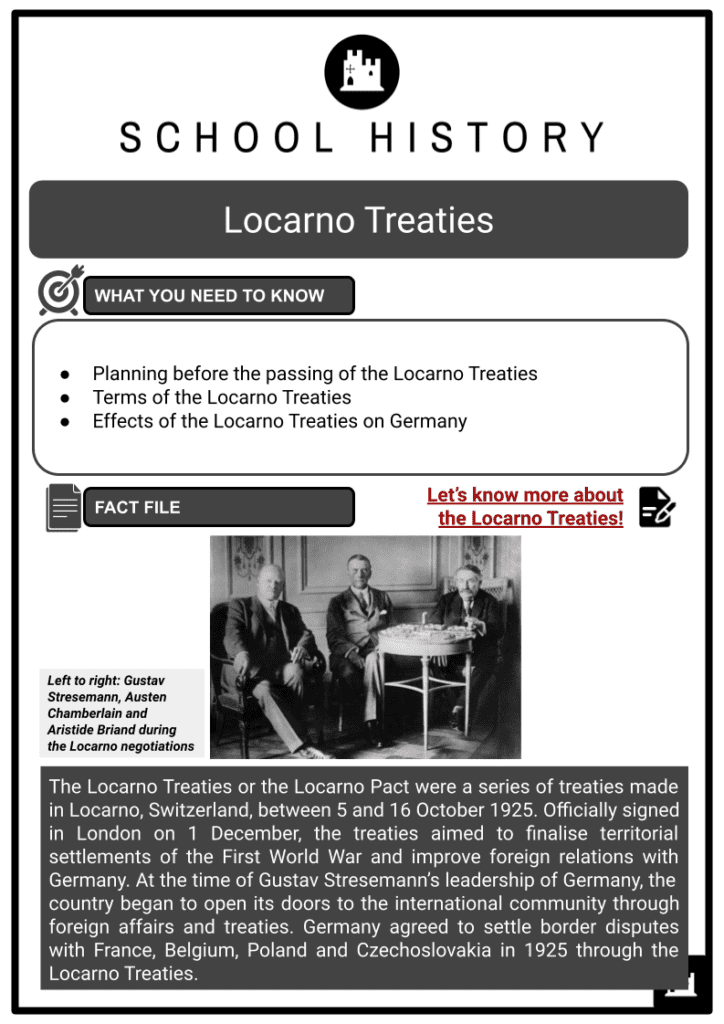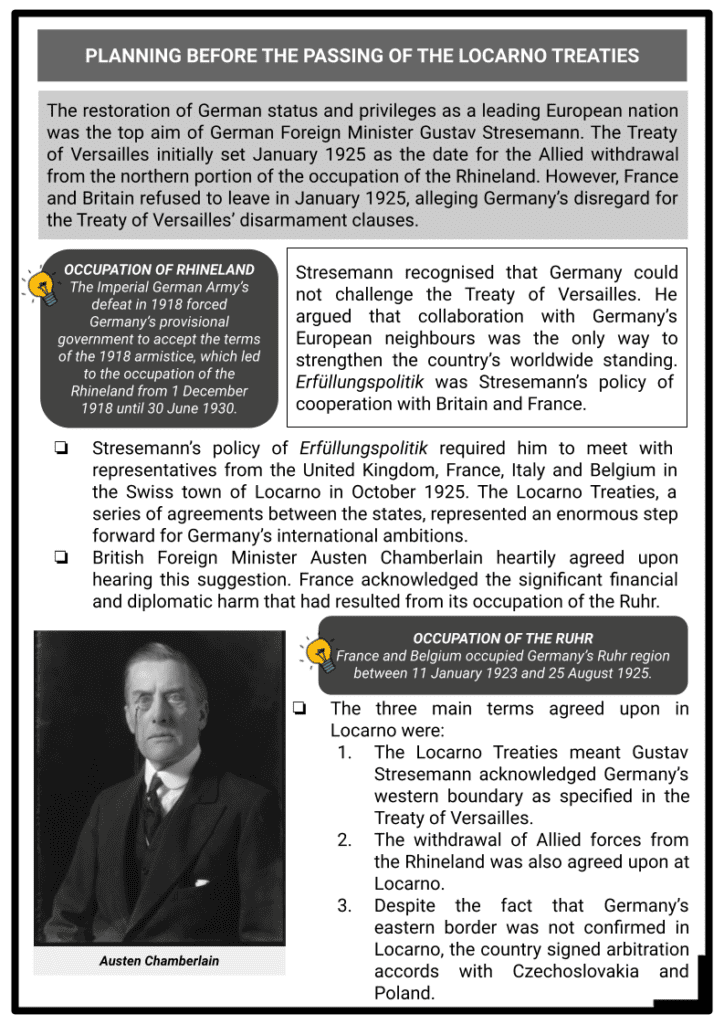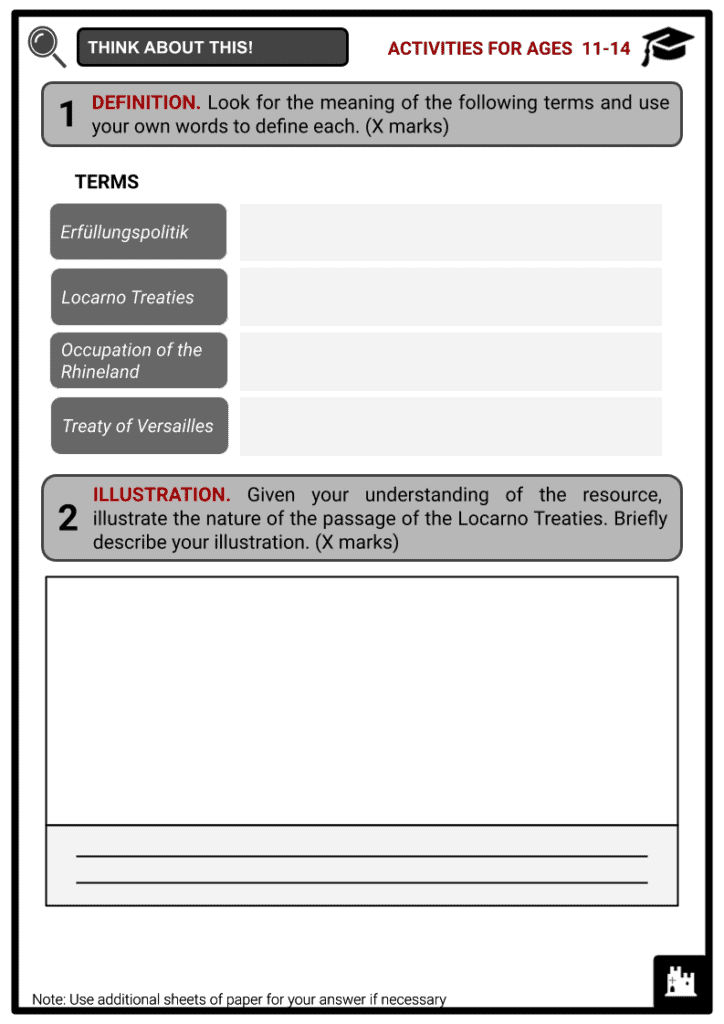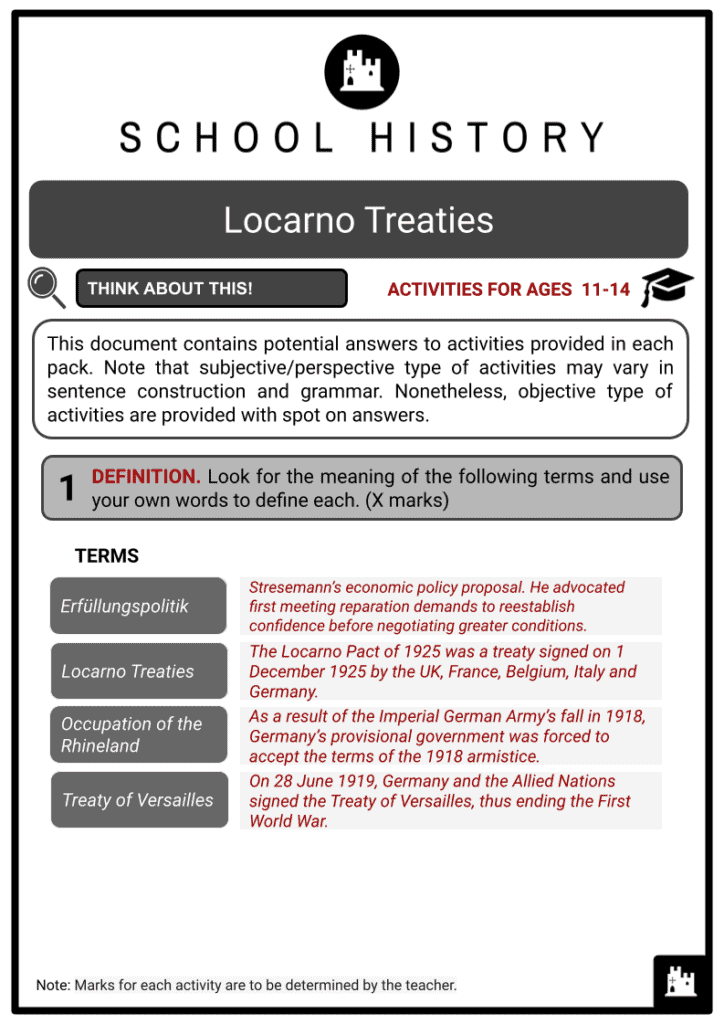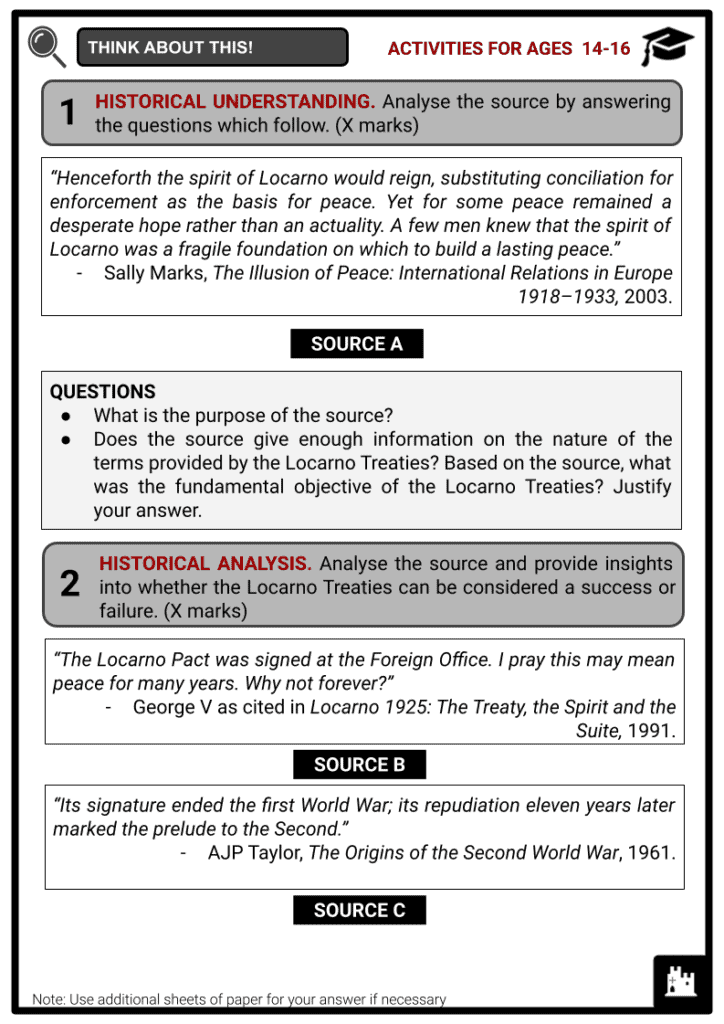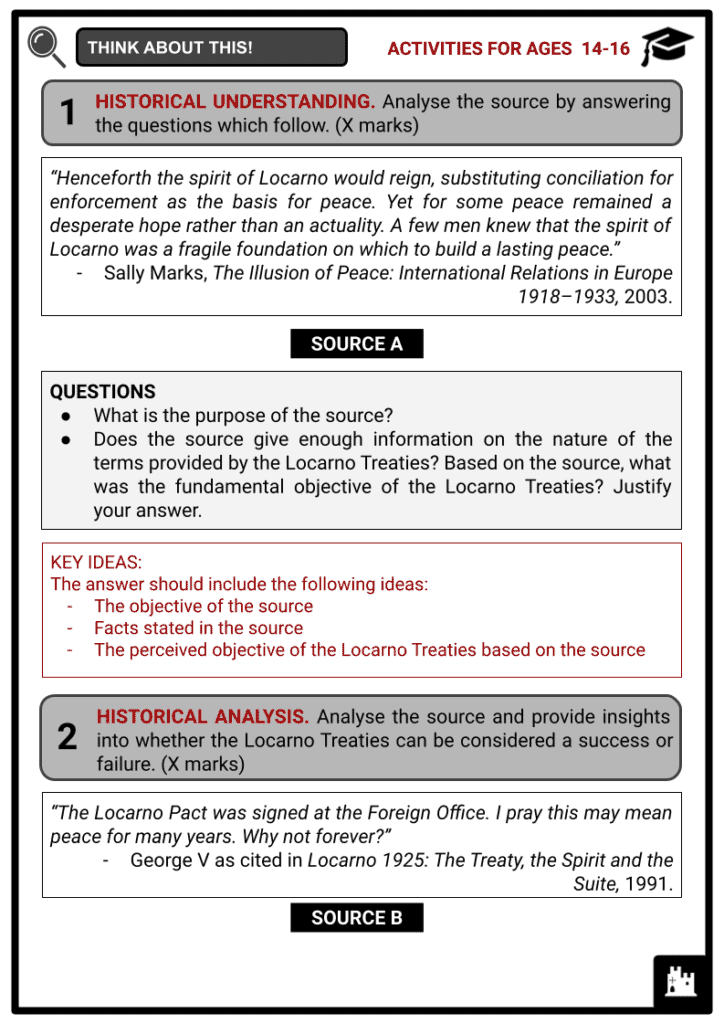Locarno Treaties Worksheets
Do you want to save dozens of hours in time? Get your evenings and weekends back? Be able to teach about the Locarno Treaties to your students?
Our worksheet bundle includes a fact file and printable worksheets and student activities. Perfect for both the classroom and homeschooling!
Summary
- Planning before the passing of the Locarno Treaties
- Terms of the Locarno Treaties
- Effects of the Locarno Treaties on Germany
Key Facts And Information
Let’s know more about the Locarno Treaties!
The Locarno Treaties or the Locarno Pact were a series of treaties made in Locarno, Switzerland, between 5 and 16 October 1925. Officially signed in London on 1 December, the treaties aimed to finalise territorial settlements of the First World War and improve foreign relations with Germany. At the time of Gustav Stresemann’s leadership of Germany, the country began to open its doors to the international community through foreign affairs and treaties. Germany agreed to settle border disputes with France, Belgium, Poland and Czechoslovakia in 1925 through the Locarno Treaties.
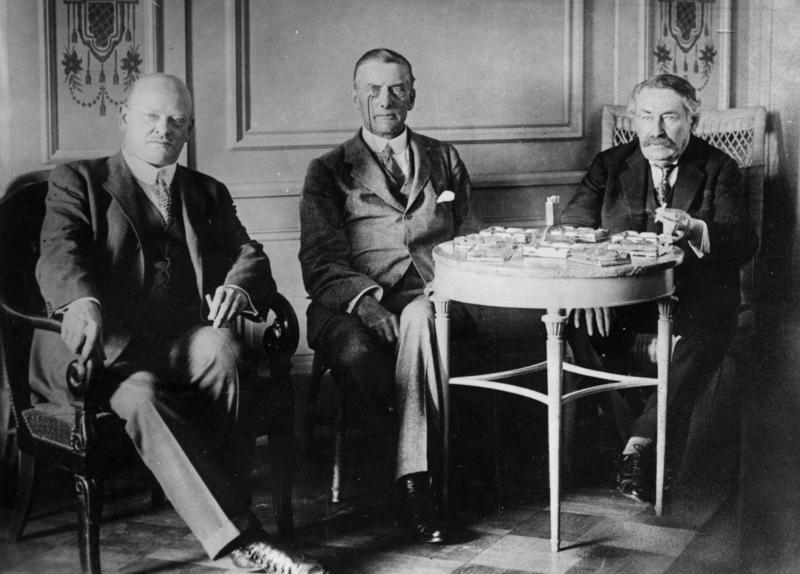
PLANNING BEFORE THE PASSING OF THE LOCARNO TREATIES
- The restoration of German status and privileges as a leading European nation was the top aim of German Foreign Minister Gustav Stresemann. The Treaty of Versailles initially set January 1925 as the date for the Allied withdrawal from the northern portion of the occupation of the Rhineland. However, France and Britain refused to leave in January 1925, alleging Germany’s disregard for the Treaty of Versailles’ disarmament clauses.
OCCUPATION OF RHINELAND
The Imperial German Army’s defeat in 1918 forced Germany’s provisional government to accept the terms of the 1918 armistice, which led to the occupation of the Rhineland from 1 December 1918 until 30 June 1930.
- Stresemann recognised that Germany could not challenge the Treaty of Versailles. He argued that collaboration with Germany’s European neighbours was the only way to strengthen the country’s worldwide standing. Erfüllungspolitik was Stresemann’s policy of cooperation with Britain and France.
- Stresemann’s policy of Erfüllungspolitik required him to meet with representatives from the United Kingdom, France, Italy and Belgium in the Swiss town of Locarno in October 1925. The Locarno Treaties, a series of agreements between the states, represented an enormous step forward for Germany’s international ambitions.
- British Foreign Minister Austen Chamberlain heartily agreed upon hearing this suggestion. France acknowledged the significant financial and diplomatic harm that had resulted from its occupation of the Ruhr.
OCCUPATION OF THE RUHR
- France and Belgium occupied Germany’s Ruhr region between 11 January 1923 and 25 August 1925. The three main terms agreed upon in Locarno were:
- The Locarno Treaties meant Gustav Stresemann acknowledged Germany’s western boundary as specified in the Treaty of Versailles.
- The withdrawal of Allied forces from the Rhineland was also agreed upon at Locarno.
- Despite the fact that Germany’s eastern border was not confirmed in Locarno, the country signed arbitration accords with Czechoslovakia and Poland.
TERMS OF THE LOCARNO TREATIES
- The terms agreed in the Locarno Treaties aimed to reassure countries that felt threatened by the Locarno agreements, particularly Poland and Czechoslovakia. Germany was obliged to provide monthly reparations payments as a result of the Dawes Plan. Due to the success of the Locarno Treaties, Germany was granted membership in the League of Nations in September 1926 and a permanent seat on its council.
DAWES PLAN
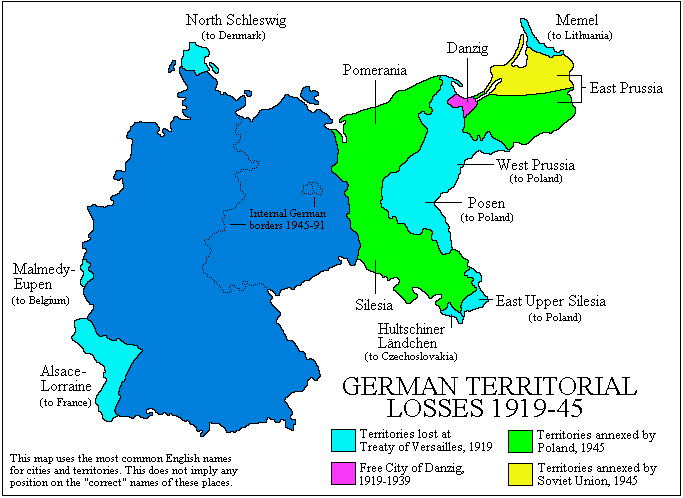
The Dawes Plan was a 1924 plan that partially handled the issue of the First World War reparations owed by Germany. It brought an end to a diplomatic crisis in Europe following the First World War and the Treaty of Versailles.
Germany’s Western Borders
- Germany lost around 10% of its area as a result of the Treaty of Versailles. Germany gave France Alsace-Lorraine, Belgium Eupen-Malmedy, Poland West Prussia, and Czechoslovakia the Sudetenland.
- Unsurprisingly, many Germans saw these terms as humiliating, with numerous factions refusing to accept such territorial losses.
- Germany, France and Belgium agreed that their shared border could stay the same. Furthermore, the UK and Italy committed to use military force if the border was attacked.
- The Locarno Treaties confirmed Germany’s western boundary but did not address Germany’s Eastern border. Many Germans believed that the eastern border with Poland and Czechoslovakia could be negotiated.
The Rhineland
- Articles 42, 43 and 44 of the 1919 Treaty of Versailles, which the Allies imposed on Germany following the First World War, stated that Germany was ‘forbidden to maintain or construct any fortification either on the Left bank of the Rhine or on the Right bank to the west of a line drawn fifty kilometres to the East of the Rhine.’
- Unlike the Treaty of Versailles, the Treaty of Locarno was regarded as significant since it reflected a voluntary German acceptance of the Rhineland’s demilitarised state.
- Since 1918, British, American, Belgian and French troops had occupied the Rhineland to secure French security against Germany. These troops were to be withdrawn in 1930, five years earlier than intended.
- The conditions of Locarno required Britain and Italy to loosely guarantee the Franco-German border and the Rhineland’s ongoing demilitarised status in the event of a flagrant violation. Under Locarno, a German attack on France compelled Britain and Italy to come to France’s help, while a French attack on Germany needed Britain and Italy to come to Germany’s aid.
- The demilitarised status of the Rhineland was dubbed the single most important guarantee of peace in Europe by American historian Gerhard Weinberg because it prevented Germany from attacking its western neighbours and because the demilitarised zone made Germany defenceless in the West by making Germany attack its eastern neighbours by leaving Germany vulnerable to a devastating French offensive if the Germans attempted to invade any state guaranteed by the French alliance system, known as the cordon sanitaire.
CORDON SANITAIRE
Referred to the system of alliances instituted by France in post-World War I Europe that stretched from Finland to the Balkans and which ‘completely ringed Germany and sealed off Russia from Western Europe, thereby isolating the two politically “diseased” nations of Europe.’
Arbitration Treaties with Poland and Czechoslovakia
- Germany’s western border with France and Belgium was confirmed as immutable, with the UK and Italy promising to protect the line militarily if necessary. Future problems would be settled peacefully by an arbitration body such as the Permanent Court of International Justice. France also forged treaties with Czechoslovakia and Poland, promising to support them if Germany invaded.
EFFECTS OF THE LOCARNO TREATIES ON GERMANY
- In 1925–1930, the Locarno Treaties showed a remarkable improvement in the political atmosphere of Western Europe. They advocated the spirit of Locarno or the expectation of continued peaceful agreements. This sentiment was solidified when Germany joined the League of Nations in 1926, as well as the withdrawal of Allied soldiers from Germany’s Rhineland. The Nobel Peace Prize was awarded to the treaty’s principal negotiators, with Chamberlain receiving it in 1925 and Aristide Briand, Prime Minister of France, and Stresemann receiving it jointly in 1926.
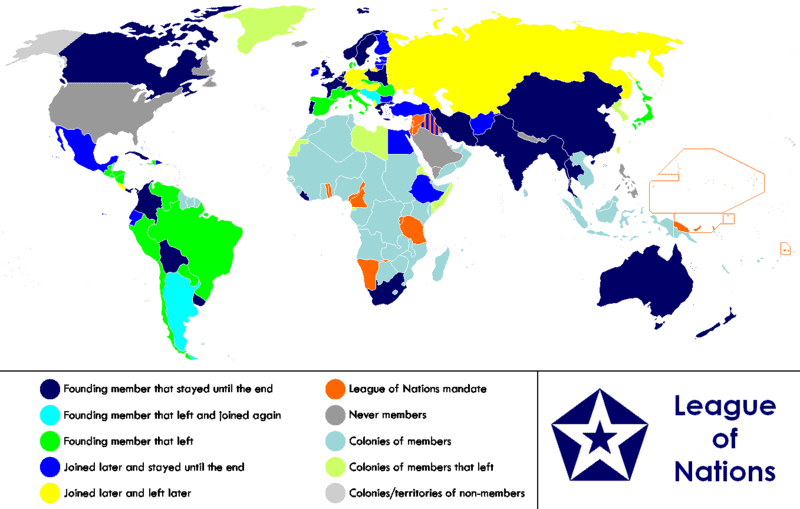
Anachronous global map depicting League member states over the League’s 26-year history
LEAGUE OF NATIONS
The League of Nations was the first global intergovernmental organisation whose primary aim was to keep the globe at peace. The Paris Peace Conference that ended the First World War established the League of Nations on 10 January 1920.
- On 7 March 1936, Adolf Hitler, Germany’s dictator, rejected Locarno by moving troops into the demilitarised Rhineland.
- The public humiliation of Polish diplomats was one of the elements that contributed to the fall of Prime Minister Władysław Grabski’s administration in Poland. Locarno contributed to the deterioration of relations between Poland and France, undermining the Franco–Polish alliance.
- Proposals for an eastern Locarno accord to secure Germany’s eastern borders failed in 1934 due to German opposition and Poland’s request that a western guarantee of its borders guarantee its eastern borders.
Frequently Asked Questions
- What are the Locarno Treaties?
The Locarno Treaties are a series of agreements signed in Locarno, Switzerland, in 1925 to promote peace and stability in Europe following World War I.
- What were the main goals of the Locarno Treaties?
The primary objectives were to establish territorial borders in Western Europe, guarantee the inviolability of these borders, and promote peaceful resolution of disputes to prevent another significant conflict.
- Which 7 countries were involved with the Locarno Treaties?
The seven countries involved in the Locarno Treaties were Germany, France, Belgium, The United Kingdom, Italy, Poland, and Czechoslovakia.

